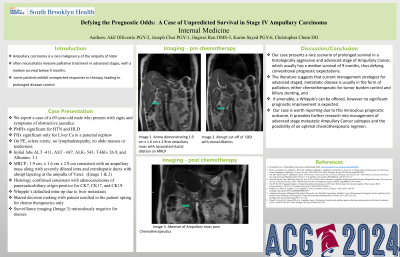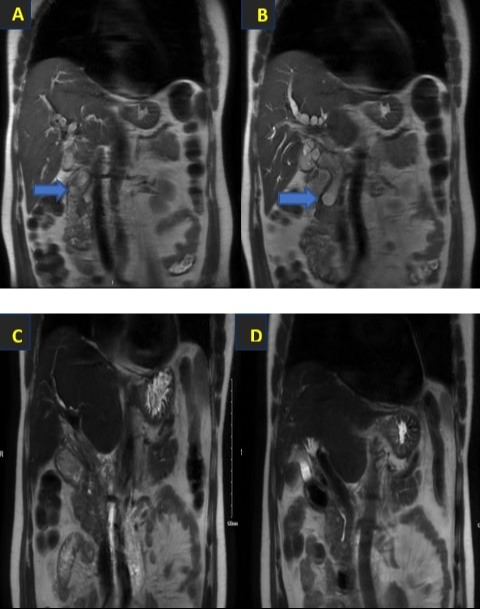Sunday Poster Session
Category: Biliary/Pancreas
P0167 - Defying the Prognostic Odds: A Case of Unpredicted Survival in Stage IV Ampullary Carcinoma
Sunday, October 27, 2024
3:30 PM - 7:00 PM ET
Location: Exhibit Hall E

Has Audio

Akil Olliverrie, MD
NYC Health + Hospitals/South Brooklyn Health
Brooklyn, NY
Presenting Author(s)
Akil Olliverrie, MD1, Jingwei Ren, 2, Joseph Choi, DO3, Syed Karim, DO1, Christopher Chum, DO3
1NYC Health + Hospitals/South Brooklyn Health, Brooklyn, NY; 2Touro College of Osteopathic Medicine, Brooklyn, NY; 3South Brooklyn Health, Brooklyn, NY
Introduction: Ampullary carcinoma is a rare malignancy of the ampulla of Vater which often necessitates invasive palliative treatment in advanced stages, with a median survival below nine months.
Case Description/Methods: We report a case of a 69-year-old male with no pertinent past medical or family history who presented with signs/symptoms of pale stools, dark urine and icteric sclera. Biochemical evaluation revealed a mixed pattern of elevated hepatic chemistries with Direct Hyperbilirubinemia. MRCP revealed a soft tissue mass with severely dilated intra and extrahepatic ducts with abrupt tapering of the CBD at the Ampulla of Vater. The patient was scheduled for a Whipple's procedure which was later aborted due to evidence of a hepatic metastasis. Pathology confirmed Pancreaticobiliary Ampullary Cancer with CK7+/CK20-/CK17+/CK19+ expression, signifying an aggressive form of Ampullary Cancer. The case was discussed at Tumor Board with shared decision making involving the patient who opted for Chemotherapeutics only. He completed two cycles and then defaulted due to side effects of chemotherapy. Post treatment surveillance imaging demonstrated absence of ampullary, biliary or hepatic mass. The patient continues to follow 3 years later in our clinic with no evidence of malignancy with 3 to 6 month surveillance imaging.
Discussion: Our case presents a rare scenario of prolonged survival in a histologically aggressive and advanced stage of Ampullary Cancer, which usually has a median survival of 9 months, thus defying conventional prognostic expectations. The literature suggests that current management strategies for advanced staged, metastatic disease is usually in the form of palliation; either chemotherapeutic for tumor burden control and biliary stenting. If amenable, a Whipple’s can be offered, however no significant prognostic improvement is expected. In our case, only a chemotherapeutic regime of FOLFIRINOX was offered due to hepatic metastasis. Surveillance MRCP and EUS post chemotherapy surprisingly revealed no appreciable lesion. The literature highlights one similar case of prolonged survival, however this case was different in that the patient was amenable to a Whipple's procedure in addition to chemotherapy with 5-fu due to absence of metastasis. Our case is worth reporting due to this miraculous prognostic outcome. It provokes further research into management of advanced stage Ampullary Cancer and their histological subtypes with the possibility of an optimal chemotherapeutic regimen.

Disclosures:
Akil Olliverrie, MD1, Jingwei Ren, 2, Joseph Choi, DO3, Syed Karim, DO1, Christopher Chum, DO3. P0167 - Defying the Prognostic Odds: A Case of Unpredicted Survival in Stage IV Ampullary Carcinoma, ACG 2024 Annual Scientific Meeting Abstracts. Philadelphia, PA: American College of Gastroenterology.
1NYC Health + Hospitals/South Brooklyn Health, Brooklyn, NY; 2Touro College of Osteopathic Medicine, Brooklyn, NY; 3South Brooklyn Health, Brooklyn, NY
Introduction: Ampullary carcinoma is a rare malignancy of the ampulla of Vater which often necessitates invasive palliative treatment in advanced stages, with a median survival below nine months.
Case Description/Methods: We report a case of a 69-year-old male with no pertinent past medical or family history who presented with signs/symptoms of pale stools, dark urine and icteric sclera. Biochemical evaluation revealed a mixed pattern of elevated hepatic chemistries with Direct Hyperbilirubinemia. MRCP revealed a soft tissue mass with severely dilated intra and extrahepatic ducts with abrupt tapering of the CBD at the Ampulla of Vater. The patient was scheduled for a Whipple's procedure which was later aborted due to evidence of a hepatic metastasis. Pathology confirmed Pancreaticobiliary Ampullary Cancer with CK7+/CK20-/CK17+/CK19+ expression, signifying an aggressive form of Ampullary Cancer. The case was discussed at Tumor Board with shared decision making involving the patient who opted for Chemotherapeutics only. He completed two cycles and then defaulted due to side effects of chemotherapy. Post treatment surveillance imaging demonstrated absence of ampullary, biliary or hepatic mass. The patient continues to follow 3 years later in our clinic with no evidence of malignancy with 3 to 6 month surveillance imaging.
Discussion: Our case presents a rare scenario of prolonged survival in a histologically aggressive and advanced stage of Ampullary Cancer, which usually has a median survival of 9 months, thus defying conventional prognostic expectations. The literature suggests that current management strategies for advanced staged, metastatic disease is usually in the form of palliation; either chemotherapeutic for tumor burden control and biliary stenting. If amenable, a Whipple’s can be offered, however no significant prognostic improvement is expected. In our case, only a chemotherapeutic regime of FOLFIRINOX was offered due to hepatic metastasis. Surveillance MRCP and EUS post chemotherapy surprisingly revealed no appreciable lesion. The literature highlights one similar case of prolonged survival, however this case was different in that the patient was amenable to a Whipple's procedure in addition to chemotherapy with 5-fu due to absence of metastasis. Our case is worth reporting due to this miraculous prognostic outcome. It provokes further research into management of advanced stage Ampullary Cancer and their histological subtypes with the possibility of an optimal chemotherapeutic regimen.

Figure: Pictures A and B: Demonstrating Ampullary Mass (A) and abrupt cut off of CBD with ductal dilation (B).
PIcture C/D: Demonstrating absence of Ampullary Mass three years later post chemotherapy on surveillance imaging
PIcture C/D: Demonstrating absence of Ampullary Mass three years later post chemotherapy on surveillance imaging
Disclosures:
Akil Olliverrie indicated no relevant financial relationships.
Jingwei Ren indicated no relevant financial relationships.
Joseph Choi indicated no relevant financial relationships.
Syed Karim indicated no relevant financial relationships.
Christopher Chum indicated no relevant financial relationships.
Akil Olliverrie, MD1, Jingwei Ren, 2, Joseph Choi, DO3, Syed Karim, DO1, Christopher Chum, DO3. P0167 - Defying the Prognostic Odds: A Case of Unpredicted Survival in Stage IV Ampullary Carcinoma, ACG 2024 Annual Scientific Meeting Abstracts. Philadelphia, PA: American College of Gastroenterology.
